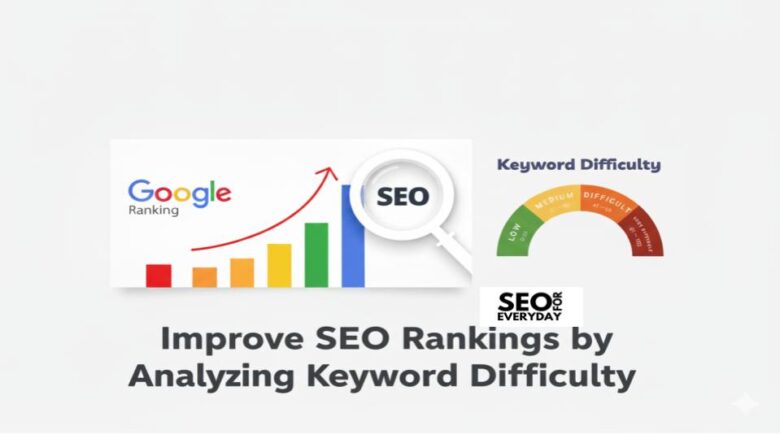Introduction
If you’ve ever wondered why some websites quickly rank on Google while others struggle, the secret often lies in understanding keyword difficulty. Keyword difficulty tells you how challenging it is to rank for a specific keyword. Without analyzing it, you might waste time chasing keywords that are nearly impossible to rank for.
In this guide, we’ll break down how to analyze keyword difficulty step by step so you can rank faster and smarter.
Understanding Keyword Difficulty
Definition of Keyword Difficulty
Keyword difficulty is a metric that shows how hard it is to rank on the first page of search engines for a specific keyword. Most SEO tools give this metric as a score from 0 to 100—the higher the score, the harder it is.
Factors Influencing Keyword Difficulty
Competition Level
If too many websites are targeting the same keyword, it becomes harder to stand out.
Domain Authority of Competitors
Websites with strong authority (like Wikipedia, Forbes, or established blogs) dominate SERPs, making it tough for newer sites to compete.
Content Quality and Relevance
Even with lower authority, a well-written, highly relevant piece of content can rank above weaker pages.
Backlinks and Link Profiles
Strong backlink networks boost keyword rankings. If competitors have thousands of quality backlinks, it raises the keyword’s difficulty.
Why Keyword Difficulty Matters
Helps Prioritize Keywords
Instead of targeting every keyword, you can focus on the ones with a balance of low competition and good search volume.
Saves Time and Resources
Targeting the wrong keywords wastes content efforts. A smart approach ensures quicker wins.
Increases Chances of Ranking Faster
By analyzing difficulty, you can find keywords where your website has a real chance to rank.
Tools to Analyze Keyword Difficulty
Free Keyword Research Tools
Google Keyword Planner
A classic free tool from Google that shows search volume and competition levels.
Ubersuggest
Neil Patel’s tool gives keyword difficulty scores, content ideas, and backlink data.
Paid Keyword Research Tools
Ahrefs
Provides a keyword difficulty score and shows backlink data of top-ranking pages.
SEMrush
One of the most powerful SEO tools with detailed keyword competition analysis.
Moz Keyword Explorer
Simplifies keyword difficulty with an easy-to-understand score and SERP analysis.
Step-by-Step Guide to Analyzing Keyword Difficulty
Step 1 – Identify Your Seed Keywords
Start with a list of broad keywords related to your niche.
Step 2 – Check Search Volume vs. Competition
Look for keywords with moderate search volume but low competition.
Step 3 – Evaluate SERP Results
Type the keyword into Google. Check who is ranking—big authority sites or smaller blogs?
Step 4 – Analyze Backlink Profiles
Use tools like Ahrefs to see how many backlinks top-ranking pages have.
Step 5 – Check Domain and Page Authority
Moz and Ahrefs give authority scores. Competing with sites of similar authority is easier.
Step 6 – Look for Content Gaps
Find what existing articles miss and create better, more valuable content.
Balancing Keyword Difficulty with Search Intent
Informational Keywords
Used by people searching for knowledge (e.g., “what is SEO”).
Transactional Keywords
Show buying intent (e.g., “buy running shoes online”).
Navigational Keywords
Help users find specific brands or websites (e.g., “Facebook login”).
Commercial Investigation Keywords
Used by people comparing products/services (e.g., “best laptops under $1000”).
How to Target Low-Difficulty Keywords for Faster Ranking
Long-Tail Keywords
Instead of targeting “shoes,” go for “best running shoes for flat feet 2025.”
Location-Based Keywords
If you run a local business, target terms like “SEO agency in Dhaka.”
Question-Based Keywords
Answer queries like “how to analyze keyword difficulty” to capture voice search traffic.
Common Mistakes in Analyzing Keyword Difficulty
Focusing Only on Search Volume
High search volume often means high competition.
Ignoring Content Quality
You won’t rank without delivering better content than your competitors.
Neglecting Search Intent
Ranking won’t help if the content doesn’t meet what users actually want.
Overlooking SERP Features
Google often displays snippets, videos, or “People Also Ask” sections—these affect ranking chances.
Advanced Tips to Outrank Competitors
Improve On-Page SEO
Use keywords in titles, headers, and meta descriptions.
Build Quality Backlinks
Guest posts, outreach, and partnerships help strengthen your authority.
Optimize for User Experience
Fast loading, mobile-friendly, and easy navigation boost rankings.
Leverage Content Freshness
Updating your content regularly helps outperform outdated posts.
Real-Life Example of Keyword Difficulty Analysis
Let’s say you want to rank for “best budget laptops.”
- Search volume: 15,000/month
- Keyword difficulty: 70 (high)
- Top competitors: TechRadar, CNET, LaptopMag (high authority sites)
Instead of chasing this, you could target “best budget laptops under $500 in 2025” with lower difficulty and less competition.
Conclusion
Analyzing keyword difficulty is like scouting the battlefield before going to war. By knowing your strengths and weaknesses, you can choose the right battles to win. With smart keyword research, even small websites can outrank big competitors and achieve fast rankings.
Frequently Asked Question
If top results are dominated by authority sites with thousands of backlinks, it’s likely too difficult.
It’s possible, but it usually takes time, quality content, and strong backlinks.
For new websites, aim for scores under 30–40.
Not always, but generally they’re easier to rank for than broad keywords.
Every 3–6 months, as competition and search behavior change.








Leave a Reply